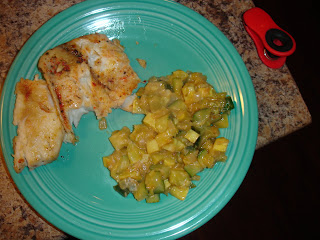Last July, Nick and I decided to shake things up and do the South Beach Diet. I feel like calling it a diet sounds a bit silly because it wasn't something that we did, lost a whole bunch of weight, and then stopped. After we each lost some substantial weight , we've kept up the diet for our primary meals and snacks. Indulging had become perhaps a bit too common, but overall we didn't gain back much- just fluctuated a few pounds.
South Beach is really about living a low glycemic life style as much as possible. Low glycemic is a word often used in conjunction with diabetes as it's all about controlling your blood sugar. When you eat food that has sugar in it, your pancreas releases insulin. Too much sugar that isn't tempered by a complex carb, fat, or protein trains the pancreas to release insulin erratically, which only makes you want sugar more. It's a vicious cycle!
The benefit of this way of eating is that it allows you to take care of weight you carry in the middle first and foremost- hooray! Currently we're doing phase 1 which is the strictest phase, but it's hardly an imposition. I just snacked on some hummus and red bell pepper. Other snacks include spoonfuls of almond butter (straight from the jar if you're classy like me), low fat string cheese, pistachios, sugar-free jello. Not a lot of options, but I'm not a picky eater- I just don't want to be hungry!
South Beach encourages you to eat until you're full- hallelujah! The calorie/point/carb counting shenanigans really stresses me out. Suffice it say, South Beach works for us and if you're interested in learning more you should read this.
As I step away from my soap box, I'll get to explaining where I found this delicious dish. Kalyn's Kitchen is a blog dedicated to South Beach and healthy cooking in general. This recipe is taken directly from her blog with the exception of adding the El Fenix salsa at the end- that's all me.
 Cast of characters: low-fat (NOT fat-free) shredded cheese, 4 oz. green chile (you could use some jalapenos if you're feeling spicy), diced onion (1 small), chopped summer squash and zucchini (4 medium-sized squash)
Cast of characters: low-fat (NOT fat-free) shredded cheese, 4 oz. green chile (you could use some jalapenos if you're feeling spicy), diced onion (1 small), chopped summer squash and zucchini (4 medium-sized squash) This is a picture of my "YELLOW" onion that has a decidedly pinkish hue. It's a conspiracy!
This is a picture of my "YELLOW" onion that has a decidedly pinkish hue. It's a conspiracy! Saute the onion in about 1 tablespoon of oil over medium heat. Wait for it to get a little color and for onions to be soft.
Saute the onion in about 1 tablespoon of oil over medium heat. Wait for it to get a little color and for onions to be soft. Dump in the squash and saute until it's tender crisp.
Dump in the squash and saute until it's tender crisp. Throw in the green chile and stir to combine.
Throw in the green chile and stir to combine. Add a few generous handfuls of cheese.
Add a few generous handfuls of cheese. Stir to combine and allow cheese to melt.
Stir to combine and allow cheese to melt. Then stir in several tablespoons of ambrosia, a.k.a. El Fenix hot sauce. If you ever happen to be in my hometown of Dallas, TX you should eat there. Might I recommend the Wednesday Enchilada Special...*drool*
Then stir in several tablespoons of ambrosia, a.k.a. El Fenix hot sauce. If you ever happen to be in my hometown of Dallas, TX you should eat there. Might I recommend the Wednesday Enchilada Special...*drool*
Serve alongside some tilapia or other lean protein. For some reason, I am unable to make fish on the stove top that doesn't look like mangled cat food.

If you have any helpful tips, please let me know because my pans look like this after I cook fish. Boo.
Head over to Kalyn's slice of cyberspace for the full recipe and many more tasty treats!


















